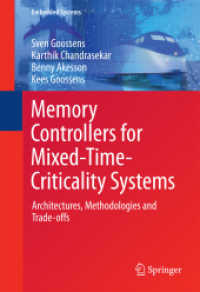- ホーム
- > 洋書
- > 英文書
- > Computer / General
Full Description
* Presenting the most comprehensive and practical introduction to the principles of software engineering and how to apply them, this updated edition follows an object-oriented perspective * Includes new and expanded material on agile and emerging methods, metrics, quality assurance security, real-world case studies, refactoring, test-driving development, and testing * Case studies help readers learn the importance of quality factors, appropriate design, and project management techniques
Contents
CONTENTS Preface The Issue of Scale This Edition Compared with the First How Instructors Can Use This Book Acknowledgments PART I Goals and Terminology of Software Engineering What is Software Engineering Why Software Engineering Is Critical: Software Disasters Why Software Fails and Succeeds Software Engineering Activities Software Engineering Principles Ethics in Software Engineering Case Studies Summary Exercises Bibliography Chapter 2 Introduction to Quality and Metrics in Software Engineering 2.1 The Meaning of Software Quality 2.2 Defects in Software 2.3 Verification and Validation 2.4 Planning for Quality 2.5 Metrics 2.6 Summary 2.7 Exercises Bibliography PART II SOFTWARE PROCESS Chapter 3 Software Process 3.1 The Activities of Software Process 3.2 Software Process Models 3.3 Case Study: Student Team Guidance 3.4 Summary 3.5 Exercises Bibliography Chapter 4 Agile Software Processes 4.1 Agile History and Agile Manifesto 4.2 Agile Principles 4.3 Agile Methods 4.4 Agile Processes 4.5 Integrating Agile with Non-Agile Processes 4.6 Summary 4.7 Exercises Bibliography Chapter 5 Quality in the Software Process 5.1 Principles of Managing Quality 5.2 Managing Quality in Agile Processes 5.3 Quality Planning 5.4 Inspections 5.5 QA Reviews and Audits 5.6 Defect Management 5.7 Process Improvement and Process Metrics 5.8 Organization-Level Quality and the CMMI 5.9 Case Study 5.10 Summary 5.11 Exercises Bibliography Chapter 6 Software Configuration Management 6.1 Software Configuration Management Goals 6.2 SCM Activities 6.3 Configuration Management Plans 6.4 Configuration Management Systems 6.5 Case Study: Encounter Video Game 6.6 Case Study: Eclipse 6.7 Student Team Guidance: Configuration Management 6.8 Summary 6.9 Exercises Bibliography PART III PROJECT MANAGEMENT Chapter 7 Principles of Software Project Management I: Organization, Tools, and Risk Management 7.1 Software Project Organization 7.2 Team Size 7.3 Geographically Distributed Development 7.4 The Team Software Process 7.5 Software Project Tools and Techniques 7.6 Risk Management 7.7 Student Team Guidance: Organizing the Software Project s Management 7.8 Summary 7.9 Exercises Bibliography Chapter 8 Principles of Software Project Management II: Estimation, Scheduling, and Planning 8.1 Cost Estimation 8.2 Scheduling 8.3 The Software Project Management Plan 8.4 Case Study: Encounter Project Management Plan 8.5 Case Study: Project Management in Eclipse 8.6 Case Study: Project Management for OpenOffice 8.7 Case Study: Student Team Guidance 8.8 Summary 8.9 Exercises Bibliography Chapter 9 Quality and Metrics in Project Management 9.1 Cultivating and Planning Internal Quality 9.2 Project Metrics 9.3 Using Metrics for Improvement 9.4 Software Verification and Validation Plan 9.5 Case Study: Software Verification and Validation Plan for Encounter 9.6 Summary 9.7 Exercises Bibliography PART IV REQUIREMENTS ANALYSIS Chapter 10 Principles of Requirements Analysis 10.1 The Value of Requirements Analysis 10.2 Sources of Requirements 10.3 High-level vs. Detailed Requirements 10.4 Types of Requirements 10.5 Nonfunctional Requirements 10.6 Documenting Requirements 10.7 Traceability 10.8 Agile Methods and Requirements 10.9 Updating the Project to Reflect Requirements Analysis 10.10 Summary 10.11 Exercises Bibliography Chapter 11 Analyzing High-Level Requirements 11.1 Examples of Customer Wants 11.2 Stakeholder Vision 11.3 The Interview and Documentation Process 11.4 Writing an Overview 11.5 Describing Main Functions and Used Cases 11.6 Agile Methods for High-Level Requirements 11.7 Specifying User Interfaces: High Level 11.8 Security Requirements 11.9 Using Diagrams for High-Level Requirements 11.10 Case Study: High-Level Software Requirements Specifications (SRS) for the Encounter Video Game 11.11 Case Study: High-Level Requirements for Eclipse 11.12 Case Study: High-Level Requirements for OpenOffice 11.13 Summary 11.14 Exercises Bibliography Chapter 12 Analyzing Detailed Requirements 12.1 The Meaning of Detailed Requirements 12.2 Organizing Detailed Requirements 12.3 User Interfaces: Detailed Requirements 12.4 Detailed Security Requirements 12.5 Error Conditions 12.6 Traceability of Detailed Requirements 12.7 Using Detailed Requirements to Manage Projects 12.8 Prioritizing Requirements 12.9 Associating Requirements with Tests 12.10 Agile Methods for Detailed Requirements 12.11 Using Tools and the Web for Requirements Analysis 12.12 The Effects on Projects of the Detailed Requirements Process 12.13 Student Project Guide: Requirements for the Encounter Case Study 12.14 Case Study: Detailed Requirements for the Encounter Video Game 12.15 Summary 12.16 Exercises Bibliography Chapter 13 Quality and Metrics in Requirements Analysis 13.1 Quality of Requirements for Agile Projects 13.2 Accessibility of Requirements 13.3 Comprehensiveness of Requirements 13.4 Understandability of Requirements 13.5 Un-ambiguity of Requirements 13.6 Consistency of Requirements 13.7 Prioritization of Requirements 13.8 Security and High-Level Requirements 13.9 Self-Completeness of Requirements 13.10 Testability of Requirements 13.11 Traceability of Requirements 13.12 Metrics for Requirements Analysis 13.13 Inspecting Detailed Requirements 13.14 Summary 13.15 Exercises Chapter 14 Online Chapter - Formal and Emerging Methods in Requirements Analysis as follows: An Introduction 14.1 Provable Requirements Method 14.2 Introduction to Formal Methods 14.3 Mathematical Preliminaries 14.4 The Z -Specification Language 14.5 The B Language System 14.6 Trade-offs for Using a B-like system 14.7 Summary 14.8 Exercises Bibliography PART V SOFTWARE DESIGN Chapter 15 Principles of Software Design 15.1 The Goals of Software Design 15.2 Integrating Design Models 15.3 Frameworks 15.4 IEEE Standards for Expressing Designs 15.6 Summary 15.7 Exercises Chapter 16 The Unified Modeling Language 16.1 Classes in UML 16.2 Class Relationships in UML 16.3 Multiplicity 16.4 Inheritance 16.5 Sequence Diagrams 16.6 State Diagrams 16.7 Activity Diagrams 16.8 Data Flow Models 16.9 A Design Example with UML 16.10 Summary 16.11 Exercises Bibliography Chapter 17 Software Design Patterns 17.1 Examples of a Recurring Design Purpose 17.2 An Introduction to Design Patterns 17.3 Summary of Design Patterns by Type: Creational, Structural, and Behavioral 17.4 Characteristics of Design Patterns: Viewpoints, Roles, and Levels 17.5 Selected Creational Design Patterns 17.6 Selected Structural Design Patterns 17.7 Selected Behavioral Design Patterns 17.8 Design Pattern Forms: Delegation and Recursion 17.9 Summary 17.10 Exercises Bibliography Chapter 18 Software Architecture 18.1 A Categorization of Architectures 18.2 Software Architecture Alternatives and Their Class Models 18.3 Trading Off Architecture Alternatives 18.4 Tools for Architectures 18.5 IEEE Standards for Expressing Designs 18.6 Effects of Architecture Selection on the Project Plan 18.7 Case Study: Preparing to Design Encounter (Student Project Guide continued) 18.8 Case Study: Software Design Document for the Role-Playing Video Game Framework 18.9 Case Study: Software Design Document for Encounter (Uses the Framework) 18.10 Case Study: Architecture of Eclipse 18.11 Case Study: OpenOffice Architecture 18.12 Summary 18.13 Exercises Bibliography Chapter 19 Detailed Design 19.1 Relating Use Cases, Architecture, and Detailed Design 19.2 A Typical Road Map for the Detailed Design Process 19.3 Object-Oriented Design Principles 19.4 Designing against Interfaces 19.5 Specifying Classes, Functions, and Algorithms 19.6 Reusing Components 19.7 Sequence and Data Flow Diagrams for Detailed Design 19.8 Detailed Design and Agile Processes 19.9 Design in the Unified Development Process 19.10 IEEE Standard 890 for Detailed Design 19.11 Updating a Project with Detailed Design 19.12 Case Study: Detailed Design of Encounter 19.13 Case Study: Detailed Design of Eclipse 19.14 Summary 19.15 Exercises Bibliography Chapter 20 Design Quality and Metrics 20.1 Degree of Understandability, Cohesion, and Coupling 20.2 Degree of Sufficiency as a Quality Goal 20.3 Degree of Robustness as a Quality Goal 20.4 Degree of Flexibility as a Design Quality Goal 20.5 Degree of Reusability as a Design Quality Goal 20.6 Degree of Time Efficiency as a Design Quality Measure 20.7 Degree of Space Efficiency as a Design Quality Measure 20.8 Degree of Reliability as a Design Quality Measure 20.9 Degree of Security as a Design Quality Measure 20.10 Assessing Quality in Architecture Selection 20.11 Assessing the Quality of Detailed Designs 20.12 Summary 20.13 Exercises Bibliography Chapter 21 Online Chapter - Advanced and Emerging Methods in Software Design 21.1 Designing in a Distributed Environment 21.2 Introduction to Aspect-Oriented Programming 21.3 Designing for Security with UMLsec 21.4 Model-Driven Architectures 21.5 The Formal Design Process in B 21.6 Summary 21.7 Exercises Bibliography PART VI IMPLEMENTATION Chapter 22 Principles of Implementation 22.1 Agile and Non-Agile Approaches to Implementation 22.2 Choosing a Programming Language 22.3 Identifying Classes 22.4 Defining Methods 22.5 Implementation Practices 22.6 Defensive Programming 22.7 Coding Standards 22.8 Comments 22.9 Tools and Environments for Programming 22.10 Case Study: Encounter Implementation 22.11 Case Study: Eclipse 22.12 Case Study: OpenOffice 22.13 Student Team Guidance for Implementation 22.14 Summary 22.15 Code Listings Referred to in This Chapter 22.16 Exercises Bibliography Chapter 23 Quality and Metrics in Implementation 23.1 Quality of Implementation 23.2 Code Inspections 23.3 Summary 23.4 Exercises Chapter 24 Refactoring 24.1 Big Refactorings 24.2 Composing Methods 24.3 Moving Features between Objects 24.4 Organizing Data 24.5 Generalization 24.6 Introducing Modules 24.7 Refactoring in Projects 24.8 Summary 24.9 Exercises Bibliography PART VII TESTING AND MAINTENANCE Chapter 25 Introduction to Software Testing 25.1 Testing Early and Often; and the Agile Connection 25.2 Retesting: Regression Testing 25.3 Black Box and White Box Testing 25.4 Unit Testing vs. Post-Unit Testing 25.5 Testing Object-Oriented Implementations 25.6 Documenting Tests 25.7 Test Planning 25.8 Testing Test Suites by Fault Injection 25.9 Summary 25.10 Exercises Chapter 26 Unit Testing 26.1 The Sources of Units for Unit Testing 26.2 Unit Test Methods 26.3 Testing Methods 26.4 Test-Driven Development 26.5 Case Study: Encounter Video Game 26.6 Summary 26.7 Exercises Bibliography Chapter 27 Module and Integration Testing 27.1 Stubs and Drivers 27.2 Testing a Class 27.3 Integration 27.4 Daily Builds 27.5 Interface Testing 27.6 Module Integration 27.7 Case Study: Class Test for Encounter 27.8 Case Study: Encounter Integration Plan 27.9 Summary 27.10 Exercises Bibliography Chapter 28 Testing at the System Level 28.1 Functional Testing 28.2 Nonfunctional Testing 28.3 Testing with Lightweight Requirements 28.4 Testing Shortly Before Release 28.5 Case Study: Encounter Software Test Documentation 28.6 Case Study: Eclipse 28.7 Case Study: OpenOffice 28.8 Summary 28.9 Exercises Bibliography Chapter 29 Software Maintenance 29.1 Types of Software Maintenance 29.2 Issues of Software Maintenance 29.3 Maintenance Process 29.4 IEEE Maintenance Standards 29.5 Software Evolution 29.6 Maintenance Metrics 29.7 Case Studies 29.8 Summary 29.9 Exercises Bibliography Glossary Index








